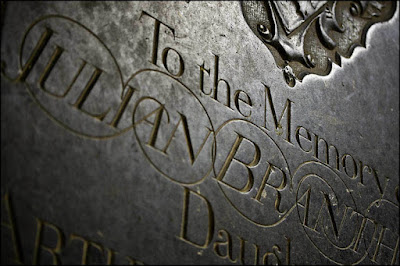A few days ago I decided to drive to a small church not far from my home to see if I could get any pleasing photographs.
I was quite pleased with these two shots of the charming little painted organ, which at one time was pumped by hand, but is now powered by electricity.
The stone slabs in the church floor over the graves of those who are buried inside the church caught my eye. I was delighted by the quality of the lettering, which still looked crisp and fresh despite having been walked on for nearly 400 years in some cases. It took a great deal of scrabbling about on the floor to get a suitable angle for these shots but I am fairly satisfied with the results.
The much reduced population of the parish of Hethel live in scattered houses down leafy lanes, and as visitors approach Hethel church - never easy to find for the first time – it is difficult for them to believe that they are a mere seven miles from busy Norwich.
Hethel people have always earned their living principally from arable farming. Generations of farmers who have struggled with its heavy clays – the Brewertons, Cranes, Claxtons, Myhills and Rackhams – are remembered in the names of houses, lanes and in the churchyard itself. One Hethel farmer, James Rush of Potash Farm, achieved national fame. One dark November night in 1848, he, made his way to Stanfield Hall and there shot dead his landlord, Isaac Jermy and his son. The crime, trial and execution caused great local excitement during the winter of 1848-9.
In a meadow to the northwest of the church is the Hethel thorn. The hawthorn (crataegus monoguna), now in rather a sad state, was described in 1864 as “having a girth of 14’ 3” at five feet from the ground, whilst the circumference of the space over which its branches spread is 31 yards”. Its trunk is now reduced to a mere shell and the branches are strangely entwined. Its bark is hard and heavy and nearly all the interior wood is gone. It is covered with lichen and crowned with mistletoe, but still blossoms profusely each spring. Tradition says that this tree is mentioned in an old chronicle as the meeting place in an insurrection during the reign of King John. The thorn is first mentioned in a deed from the early part of the thirteenth century as a boundary tree. It is certainly well over 700 years old and is now in the care of the Norfolk Wildlife Trust.
During the Second World War, Hethel airfield was an air base for the 389th group of the 2nd American Air Division. B24 Liberator bombers flew from Hethel in raids over Germany. This memorial to those who lost their lives stands just outside the church door.









3 comments:
Your photographs and words brought back memories of my trip to Scotland this past June. My son's wedding took place in Dunlop and there is a very small, very old church there much like the one in your photos. Also, Edinburgh had several very old small churches which we explored. The history and antiquity there in Great Britain is so mcuh more than what we have here in the USA.
Beautiful photos of both church and Hethel thorn. I am in awe of the history of both...I especially love the lichen and mistletoe growing in this thorn and yet it continues to bloom some hundreds of years...remarkable and thank you for the lovely tour.
I so appreciate the attention to detail that you share as you wander the grounds of Hethel.
I have a particular love for old trees and the thorn description is rich and wonderful.
Post a Comment